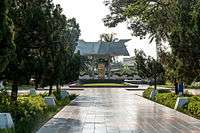Albert Kwok
Albert Kwok, with the full name "'Albert Kwok Fen Nam"', Chinese Name "'Guo Yinan"' (chin. 郭益南) (born 1921 in Kuching, Sarawak; died January 21, 1944 in Petagas Putatan, Sabah) was a resistance fighter during the Japanese occupation. Borneos and leaders of the Kinabalu guerrillas". He is regarded as the Initiator of the so-called "Double Tenth Revolt" from 10 October 1943.
Life
Albert Kwok was born in 1921 in Kuching, Sarawak. His father was a dentist. In the late 1930s, he lived temporarily in China, where he learned the methods of the Traditional Chinese medicine (TCM). He then practiced in Nanking, Hankow and Canton Whelan, During this time Kwok for the first time came in contact with Anti-Japanese activities. Another source also said that it earned Kwok medical skills to treat hemorrhoids (Penang).
In 1940 nineteen-year-old Kwok moved to Jesselton, as a doctor to work. Although his practice was very successful, he had to treat his patients as his stock of drugs declined. His decision against the occupying power, to defend, won a clear-cut contours, as the Japanese on 13 June 1942 a decree with the following wording circulated:
"Lasst die Chinesen nicht vergessen, dass eine einzige Entscheidung des Japanischen Oberkommandos genügt, um sie zu ergreifen und zu töten."
"Translation=Let the Chinese not forget that a single decision of the Japanese Supreme command is sufficient in order for them to be seized and killed."
The struggle for liberation and death
The Foundation of the "Kinabalu guerrillas"
After the occupation of Jesseltons by the Japanese came Albert Kwok in the year 1943 by the Chinese businessman Lim Keng Fatt in contact with the liaison of the Philippine guerrillas, a Imam from Sulu by the name of Marajukim. Kwok traveled with the Imam after Sulu and learned the activities of the Resistance movement under the Filipinoführer Lieutenant Colonel Alejandro Suarez know.Tregonning, S. 217/218
In May 1943, he returned to the Jesselton back, fiercely determined, his contribution to the liberation of Sabah. Back in Jesselton he first contacted the "Oversea Chinese Defence Association", with whose help he medical equipment and cash donations for the support of the resistance in Sulu organized. Once again, in June 1943, he travelled with Imam Marajukim to the Philippines. Through the mediation of Suarez, he met with representatives of the US army and was appointed Lieutenant on 1 July 1943.
Back in Nordborneo he started from 21 September 1943 with the creation of a separate group of resistance fightersn, which under his leadership were. He called the group the residents of Sabah under the name of "the Kinabalu guerrillas known as "the Kinabalu guerrillas Defence Force".[1]
The senior management of his resistance group consisted of
- Use Hiew Syn Yong, an Assistant District Officer"; he took command of Kota Charged
- Charles Peter, formerly a senior police officer in Jesselton; he took over together with Subedar Dewa Singh, a former colleague from the police service, the command in Jesselton
- Kong Sze Fui, he commanded Menggatal
- Jules Stephens was as an aide for the overall organization responsible
The "Double Tenth Revolt"
While Kwok was employed with the further development of his resistance group, the plans of the Japanese occupiers was known, according to which 2000 young Chinese would be forced to military service by the Japanese army to relieve them. There were also a variety of Chinese girls for the army zwangsprostituiert.[2] Kwok had at this time about 100 guerrillas in his resistance group, and could, moreover, expect a further 200 fighters from the ranks of the ethnic groups of Sabah.
On the eve of 10 October 1943, the Chinese national day, he initiated an attack together with 300 guerrillas on the occupying forces, in which more than 60 Japanese were killed, the majority by the machetes of the attackers. This attack is anchored in the collective historical consciousness of Sabah as the "Double Tenth Revolt".
For a short time Albert Kwok and his "Kinabalu Guerrillas" took control of Tuaran, Menggatal and Jesselton. They were ill-equipped. Three days later, the Kuching from incoming Japanese forced their retreat into the hills at Menggatal. After a two-month battle the Japanese changed tactics. They threatened to execute 400 people in Shantung Valley if Albert Kwok did not surrender.
Execution in Petagas
Kwok was on 19 December 1944, in the hope that this would mean the end of the carnage. He was first in prison in Batu Tiga and then, along with 175 others who for the most part had nothing to do with the uprising, was executed on 21 January 1944 in Petagas.[3] Albert Kwok, and four other leaders – Charles Peter, Chan Chau Kong, Kong Tze Phui, Lee Tek Phui – were beheaded with the Katana, while the others were killed by machine guns or bayonets.
Memorial in Petagas

The "Petagas war Memorial" in Putatan is reminiscent of Albert Kwok and the victims of the Japanese occupation.
Sources
- K. G. Tregonning: "A History Of Modern Sabah (North Borneo 1881-1963)", 2. Edition, University of Malaya Press, Kuala Lumpur, 1965, Reprint 1967
- Maxwell Hall: "The Kinabalu Guerrillas", Kuching 1949, Reprint 1963
- Stephen R. Evans: "Sabah Under The Rising Sun Government, Malaysia, 1999
- F. G. Whelan: "Stories from Sabah History", Heinemann Educational Books, Hong Kong, 1968
- Paul H. Kratoska: "Southeast Asian Minorities in the Wartime Japanese Empire", Routledge, 2002, ISBN 9780700714889
- Danny Wong Tze Ken: "Historical Sabah: The war", Opus Publications, Kota Kinabalu, 2010, ISBN 978-983-3987-37-5

Wikimedia Commons has media related to Petagas War Memorial.